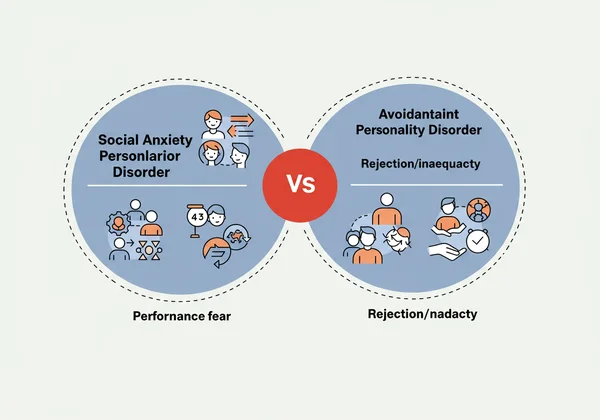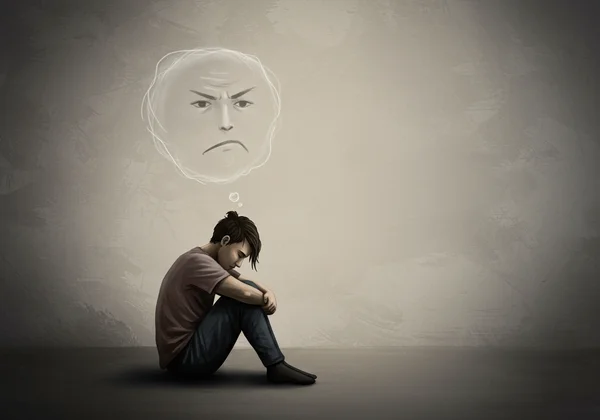Shyness, Social Anxiety, or AVPD Test: Know Your Traits
Navigating the world of social interactions can sometimes feel like walking through a minefield. If you find yourself consistently on edge, retreating from connection, or feeling a profound sense of unease around others, you might be asking yourself a critical question: Do I have social anxiety or AVPD? Many people struggle to label their experiences, wondering if it's just a personality quirk or something more significant. This article aims to clarify the distinctions, helping you distinguish between everyday shyness, Social Anxiety Disorder, and Avoidant Personality Disorder (AVPD).
Understanding these differences can be an empowering first step toward self-awareness. If you are looking for personalized insights, taking a science-based, avpd test can be a valuable tool on your journey. Let's now explore these concepts together. You can gain preliminary insights by trying our free and confidential AVPD test to explore your feelings further.
Understanding Everyday Shyness: A Common Human Trait
Shyness is a feeling of awkwardness or apprehension that many people experience in new situations or when they are the center of attention. It’s a common personality trait, not a mental health disorder. People who are shy may feel nervous before a party or a presentation, but this feeling often subsides once they become more comfortable. It's a temporary state of discomfort, not a constant state of being.
A key distinction is that shyness doesn't typically prevent someone from living a full life. While it might cause some initial hesitation, a shy person can still form meaningful relationships, succeed at work, and participate in social activities, even if it takes a little warming up.

What Does "Just Shy" Really Mean?
Being "just shy" often involves a mild fear of social judgment, but it's not overwhelming. You might worry about what to say or how you'll come across, but you don't necessarily assume rejection is inevitable. This kind of social avoidance is situational. For example, you might be quiet in a large group but open and chatty with close friends. The feeling is manageable and doesn't dictate all of your life choices. If you're curious where you fall on this spectrum, exploring your traits in a private setting can offer valuable insight.
When Shyness is Not a Disorder
The defining line between shyness and a disorder is the level of impairment. Shyness can be inconvenient and sometimes frustrating, but it doesn't fundamentally disrupt your daily functioning. You can still meet deadlines, go grocery shopping, and maintain relationships. A clinical disorder, on the other hand, creates significant and persistent distress, leading to the active avoidance of crucial life activities. Shyness is a part of who you are; a disorder feels like a barrier that stands in your way.
Social Anxiety vs. AVPD: Unpacking the Key Differences
This is where the confusion often lies for many "Confused Explorers." While Social Anxiety Disorder (SAD) and Avoidant Personality Disorder (AVPD) share a significant overlap in social fear, their underlying roots and pervasiveness are different. Distinguishing between them is crucial for finding the right path toward understanding and management.
The Core of Social Anxiety Disorder (SAD)
Social Anxiety Disorder, also known as social phobia, is characterized by an intense and persistent fear of being watched and judged by others. This fear is often tied to specific performance-based situations, like public speaking, eating in front of others, or attending social gatherings. A person with SAD is terrified of embarrassing themselves or being negatively evaluated for their actions.
The anxiety is focused on performance and scrutiny. They worry about blushing, sweating, or saying the wrong thing, fearing it will lead to humiliation. While it can be debilitating, the core fear is centered on social situations, and the person may feel relatively fine when they are alone. If these patterns resonate, it might be helpful to understand your social patterns with an initial screening.
The Pervasive Patterns of Avoidant Personality Disorder
Avoidant Personality Disorder is broader and more deeply ingrained. It is a pervasive pattern of social inhibition, feelings of inadequacy, and extreme sensitivity to negative evaluation that begins by early adulthood. The fear in AVPD is not just of embarrassment but of rejection itself. Individuals with AVPD often carry a deep-seated belief that they are socially inept, personally unappealing, or inferior to others.
This isn't just about specific situations; it's a fundamental part of their self-concept. The avpd symptoms affect nearly every area of life, leading them to avoid building intimate relationships or taking risks for fear of being rejected or ridiculed. While they may deeply desire connection, the fear of rejection is so powerful that it keeps them isolated. Taking our online avpd quiz can offer a first look into these traits.
Overlap and Distinct Features: A Comparative Look
To make the distinctions clearer, here’s a simple breakdown:
| Feature | Everyday Shyness | Social Anxiety Disorder (SAD) | Avoidant Personality Disorder (AVPD) |
|---|---|---|---|
| Core Fear | Mild fear of social judgment in new situations. | Intense fear of being negatively judged or embarrassed in social or performance situations. | Pervasive fear of rejection, criticism, and disapproval leading to a core belief of inadequacy. |
| Self-Image | Generally stable self-worth, not defined by shyness. | Self-worth can be impacted by fear of social failure, but may be stable outside of social triggers. | Pervasive feelings of being inferior, socially inept, and unappealing. |
| Avoidance | May hesitate initially but generally engages. | Avoids specific social or performance situations that trigger fear. | Avoids almost all social interaction and opportunities for close relationships unless certain of being liked. |
| Impact on Life | Minimal disruption to daily life, work, and relationships. | Can cause significant disruption in specific areas (e.g., career, social life). | Causes severe and widespread disruption across all life domains, including work and intimacy. |
This comparison highlights how these experiences exist on a spectrum. For a more personalized understanding, you can take a self-assessment designed to explore these specific traits.

Key Traits: When Social Avoidance Hints at AVPD
If the descriptions of shyness and social anxiety don't fully capture the depth of your experience, it might be worth exploring the specific avoidant personality traits. These signs go beyond simple nervousness and point to a more ingrained pattern of avoidance rooted in a negative self-view.
Beyond Discomfort: Signs of Deeper Avoidance
A key sign of potential AVPD is the active avoidance of occupational activities that require significant interpersonal contact. This isn't just about disliking group projects; it's about turning down promotions or choosing career paths well below one's capabilities solely to avoid criticism or interaction. This pattern can even be present in high functioning avpd, where an individual may appear successful on the outside but is internally tormented and makes life choices based on fear. If you see yourself in this, you can get instant insights through a confidential screening.
Inner Critic & Fear of Intimacy
The internal world of someone with AVPD traits is often dominated by a harsh inner critic. This voice constantly reinforces beliefs of inadequacy and anticipates rejection in every interaction. Consequently, they are extremely reluctant to form intimate relationships. They crave connection but will hold back from getting close to others unless they are absolutely certain of being liked and accepted without criticism. This fear of intimacy is not just about romance but extends to close friendships as well, creating a painful cycle of loneliness.

Finding Clarity: Your Path to Self-Understanding
Distinguishing between shyness, social anxiety, and AVPD is a journey of self-discovery. Recognizing these patterns is not about applying a label but about gaining the language to understand your own unique experience. Whether you identify with the mild hesitation of shyness, the situational fear of social anxiety, or the pervasive sense of inadequacy in AVPD, this knowledge empowers you.
Clarity is the first step toward compassion for yourself and, eventually, toward change. If this article has resonated with you, and you wish to explore these feelings in a private, secure environment, we encourage you to take the next step. Our platform provides a free, confidential, and scientifically-grounded screening tool to help you on your path.
Ready to gain a clearer picture? Start your self-assessment now and get immediate, easy-to-understand results.

Disclaimer: This article is for informational purposes only. The self-assessment tool is a screening instrument and not a substitute for a professional diagnosis. If you are struggling, please consider consulting with a qualified mental health professional.
Frequently Asked Questions About Social Avoidance & AVPD
Is avoidant personality disorder the same as being shy?
No, they are different. Shyness is a common personality trait characterized by temporary discomfort in social settings. Avoidant Personality Disorder (AVPD) is a pervasive mental health condition defined by deep-seated feelings of inadequacy and an intense fear of rejection that significantly impairs one's life. A free avpd test can help clarify these differences based on your personal experiences.
Do I have social anxiety or AVPD?
While both involve social fear, social anxiety is often focused on the fear of being judged or embarrassed in specific situations. AVPD is broader, stemming from a core belief of being inferior and a fear of rejection in all aspects of life, especially in close relationships. To explore where your feelings might align, our online avpd test offers a structured way to reflect on these patterns.
How do you know if you have avoidant personality disorder?
Key indicators include a persistent feeling of being "not good enough," avoiding work or school activities that involve people, being unwilling to get involved with others unless you're certain they'll like you, and extreme sensitivity to criticism. A comprehensive assessment by a professional is needed for a diagnosis, but an avpd screening tool can be an informative first step.
What are the key signs of AVPD?
The core signs of avpd include: profound feelings of inadequacy and inferiority; extreme sensitivity to criticism or disapproval; avoidance of social, professional, or personal risks; reluctance to engage in new activities; and a deep-seated fear of intimacy that prevents forming close relationships despite a desire for them.